George Frederick Bristow: Symphony No. 4 in e minor, Op. 50, “Arcadian” (1872) – Fourth movement: Allegro con spirito, “Arrival at the New Home, Rustic Festivities, and Dancing” – An Analysis by Kyle Gann
Comments Off on George Frederick Bristow: Symphony No. 4 in e minor, Op. 50, “Arcadian” (1872) – Fourth movement: Allegro con spirito, “Arrival at the New Home, Rustic Festivities, and Dancing” – An Analysis by Kyle GannOctober 10, 2019 by Admin

An Analysis by Kyle Gann
All score reductions by the author.
 Exposition — mm. 1-215
Exposition — mm. 1-215
Intro — mm. 1-8
First theme — mm. 9-18
Transitional theme — mm. 19-46
Anticipation of second theme — mm. 47-72
Second theme — mm. 73-102
Transitional area — mm. 103-145
Closing theme — mm. 146-195
Retransition — mm. 196-215
Development — mm. 216-369
Recap of introduction — mm. 216-223
First theme developed — mm. 224-243
Transitional theme developed — mm. 244-263
Closing theme developed — mm. 264-289
Second theme developed — mm. 290-341
Closing theme developed — mm. 342-369
Recapitulation — mm. 370-507
Recap of introduction — mm. 370-377
Theme A — mm. 378-393
Transitional theme — mm. 396-421
Theme B — mm. 422-451
Transitional area — mm. 452-475
Buildup to Presto — mm. 476-507
Coda – Presto — mm. 508-626
The fourth movement, “Arrival at the New Home, Rustic Festivities, and Dancing,” does not all sound as carelessly joyful as its title suggests, but it does start with a pulsing motive of perfect fourths and a burst of exhilaration from the strings.

The movement takes some curious departures from usual sonata-allegro form, which I think Bristow must have been brave to write, given how closely American works were compared to their European models. What occupies the place of the first theme, echoing between cellos and high woodwinds, is so brief, and modulates so soon, that it hardly fulfills the typical function.
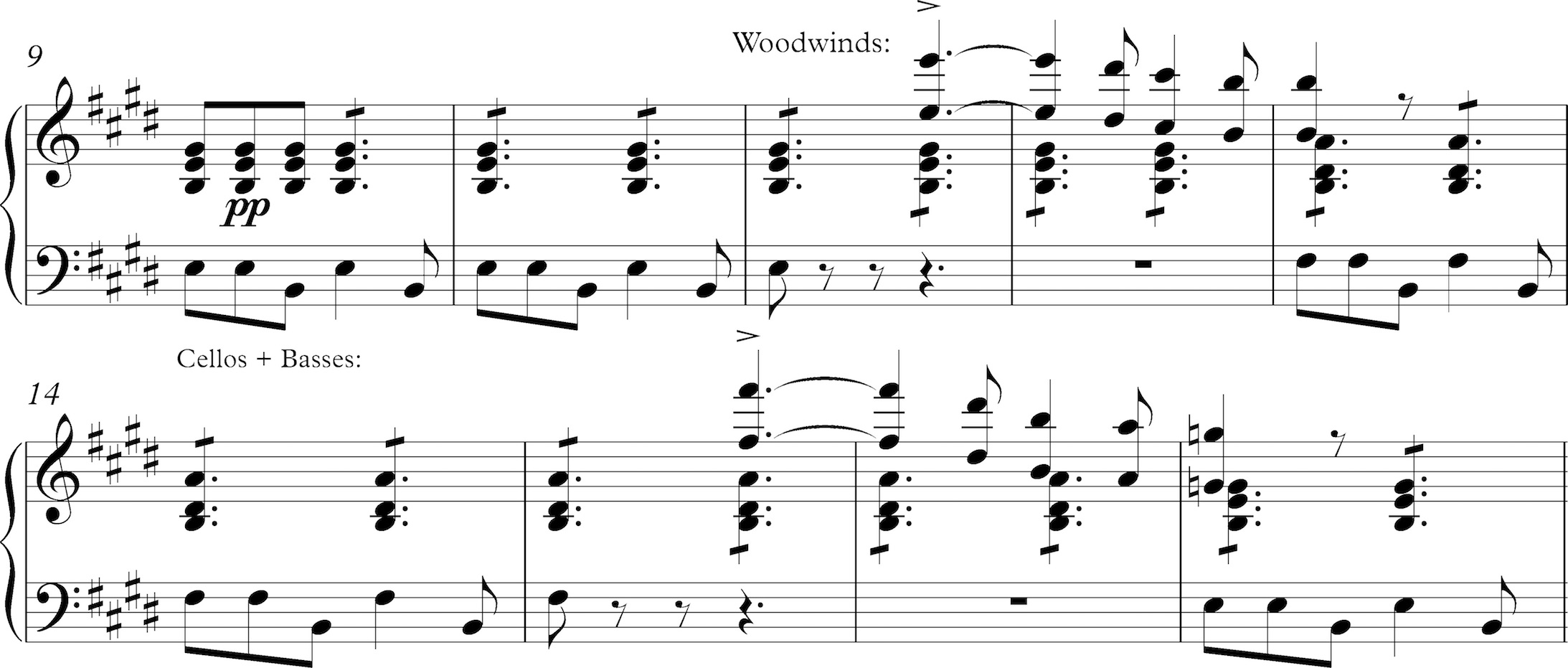
Instead, it turns from that E minor close into a tutti orchestra return of the fourths motive in C major, which, being essentially the German sixth of E, slips back into the home key rather handily. The music bounces to a cadence on F#, which sounds, in this context likely to become the dominant of B, which is likely to be the second theme’s key. Instead, the F# major turns minor, and a subsequent F# diminished seventh turns toward G major as the second key, though with so many secondary dominants and misdirections that it is a long, soft landing indeed.
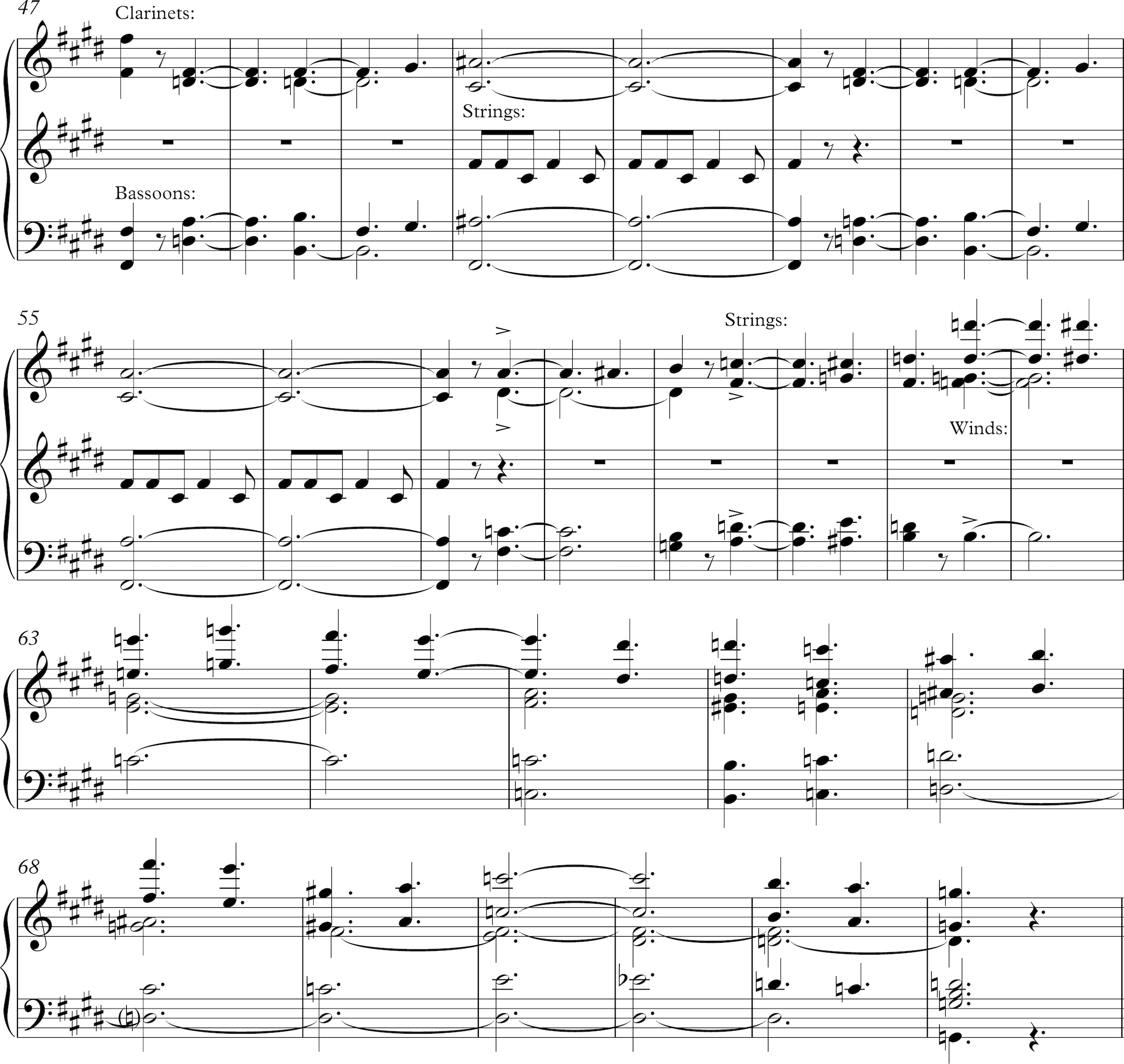
The second theme continues much in this pastoral vein, as though merely a continuation of the transition. Like the woodwind part of the first theme, the second theme also begins after its downbeat (m. 73? 75?), somewhat as an afterthought, and charmingly. Its first phrase stays within G major, but the second veers rather alarmingly into Ab major as though it, too, like the first theme, didn’t care much for its initial key, but over a long sweep it manages to slide back into G major and cadence.
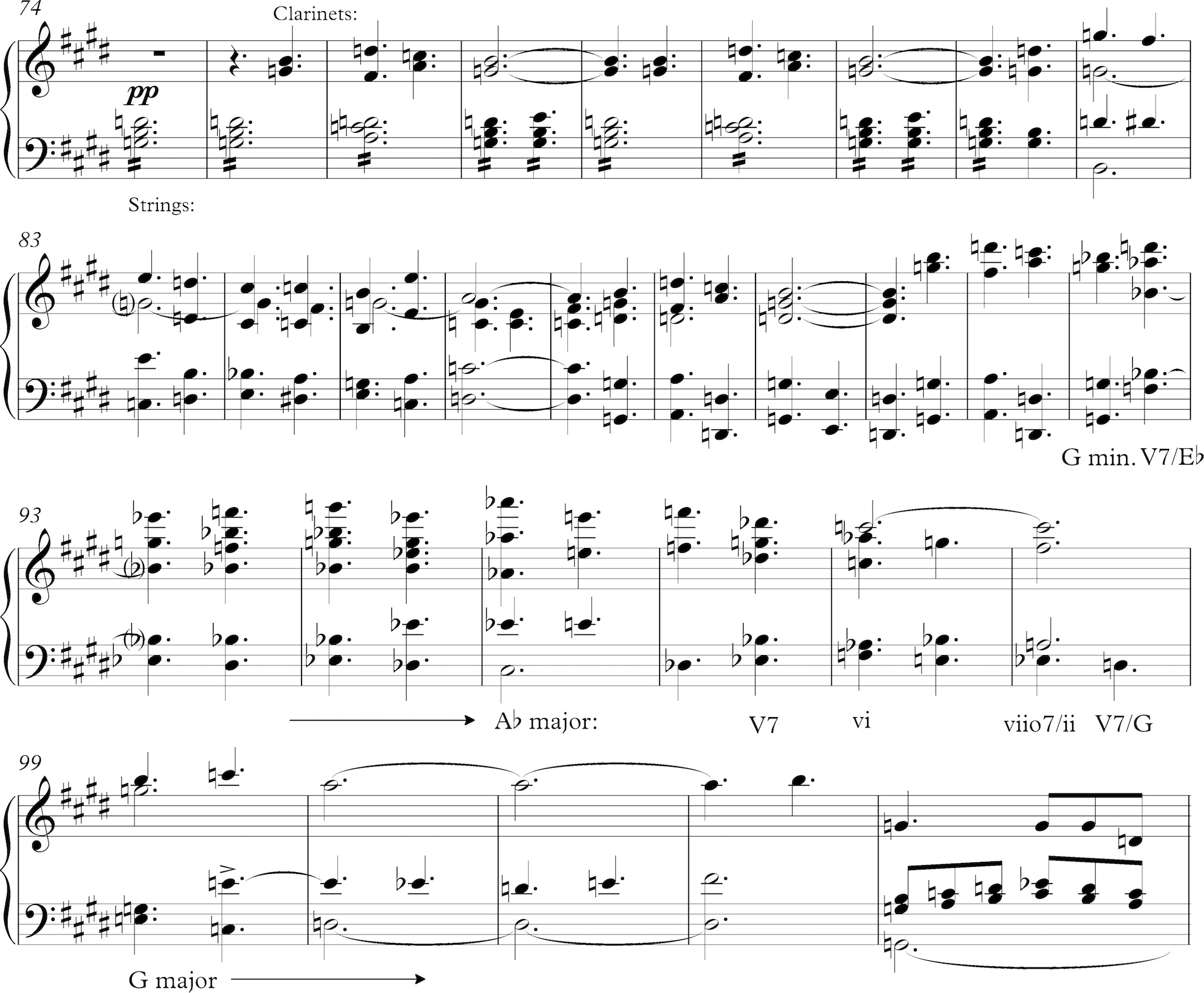
In this movement Bristow has a quick and easy modulation device: he can move his fourths motive anywhere in the scale he wants, with some woodwind motives from the second theme in-between as lubricant.

By repositioning this motive Bristow goes from G major to E minor and finally to F# major, which is now the dominant of B that we’d expected earlier. Plunging into the minor mode, though, this brings us a new, punchy theme in the bass at m. 146, a little reminiscent of the first movement, and one that suggests the celebrating pioneers may be well into their libations (or perhaps merely piling up logs for their new homes).
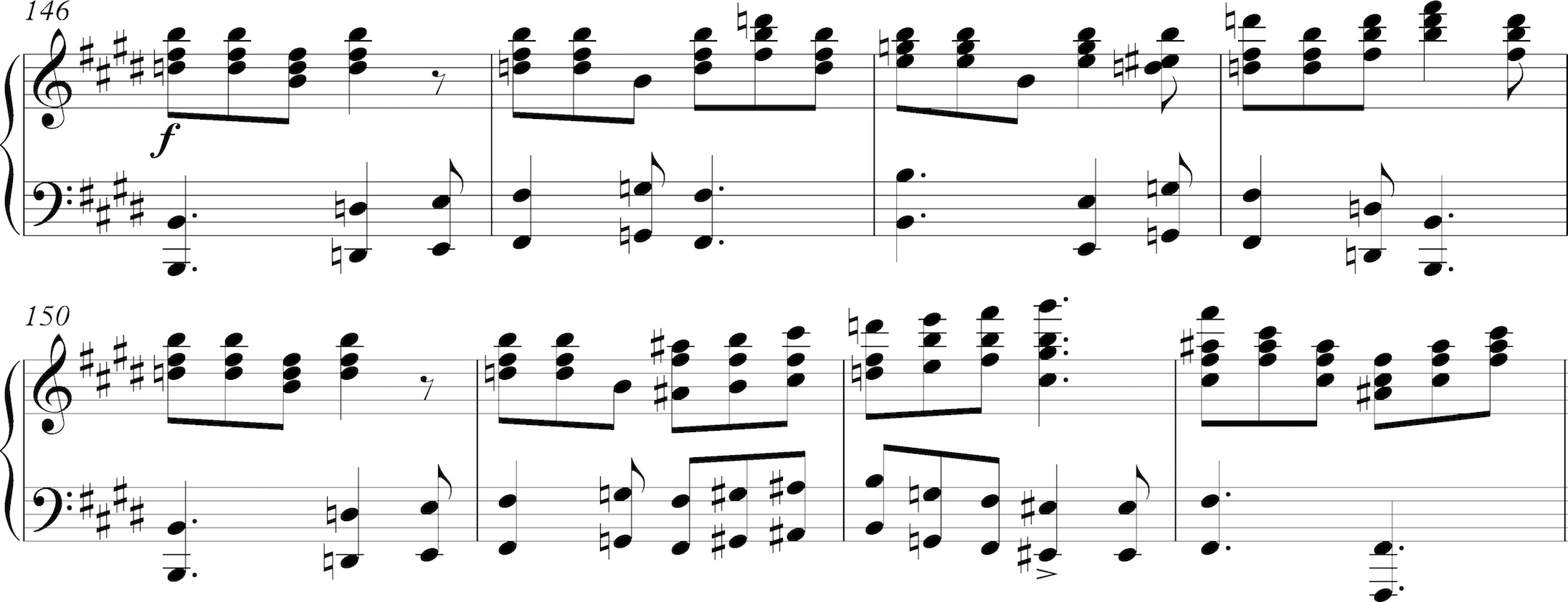
However, its triadic motive is convenient for modulations, and at m. 168 the violins take it into B major, where it takes on a more resolving tone, as though this were the real closing theme and the previous theme just the set up for it.
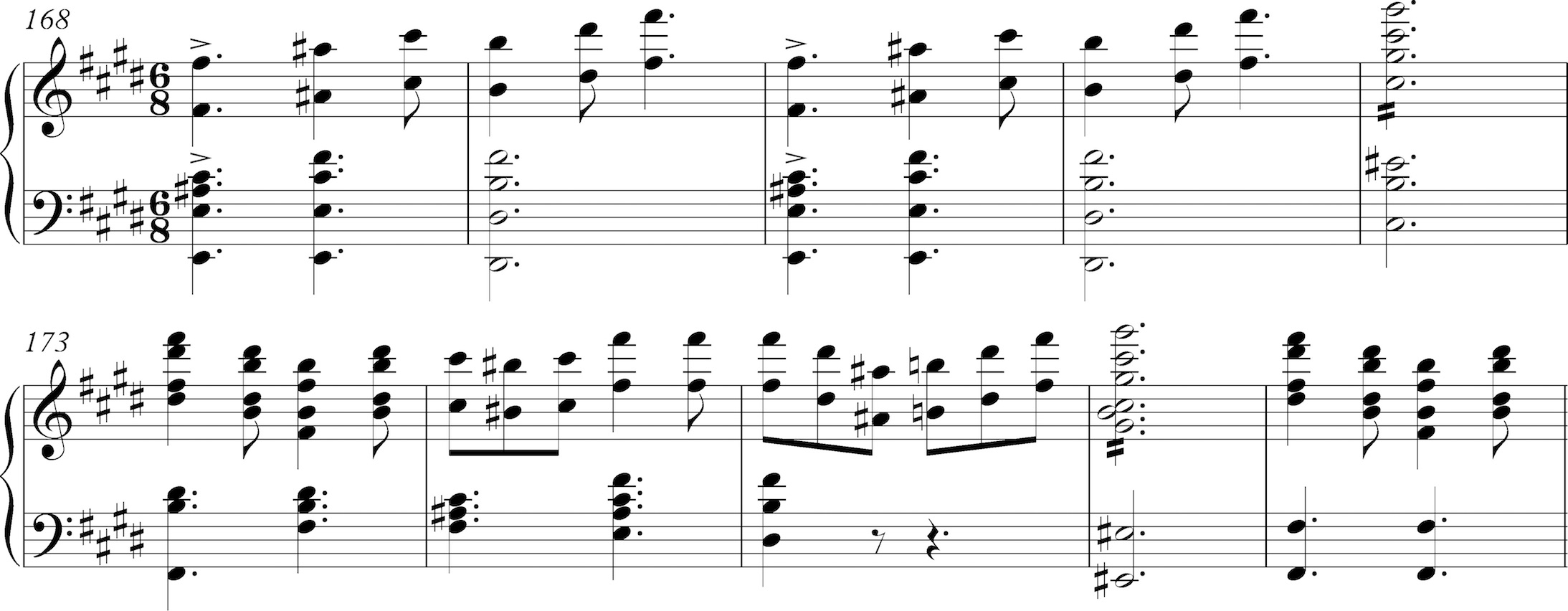
The aftermath finished off the exposition in triumph, and a nicely harmonized tune in the oboe returns us to E major – a seeming retransition, as though the exposition were going to be repeated, which it isn’t.
Nevertheless, the development does start off, oddly enough, by repeating the opening in the original key. The first theme arrives and lasts longer than it did before, undergoing some development. The transitional material is developed from mm. 244-263, and at m. 264 Bristow takes the first phrase of the closing theme as a modulating ostinato, repeating it through various harmonies and keys. By m. 280 it has reached F minor, and the music settles down to a drone on C. The next passage is remarkable; it opens with motives from the second theme, and is clearly related to it, but quite rewritten. At m. 300 the C dominant simply moves to a C# dominant as the woodwinds take it over, and with the same lingering hesitation as before, with sliding chromatic sixths added in the strings that are quite lovely, the music slowly hones in on F# major.
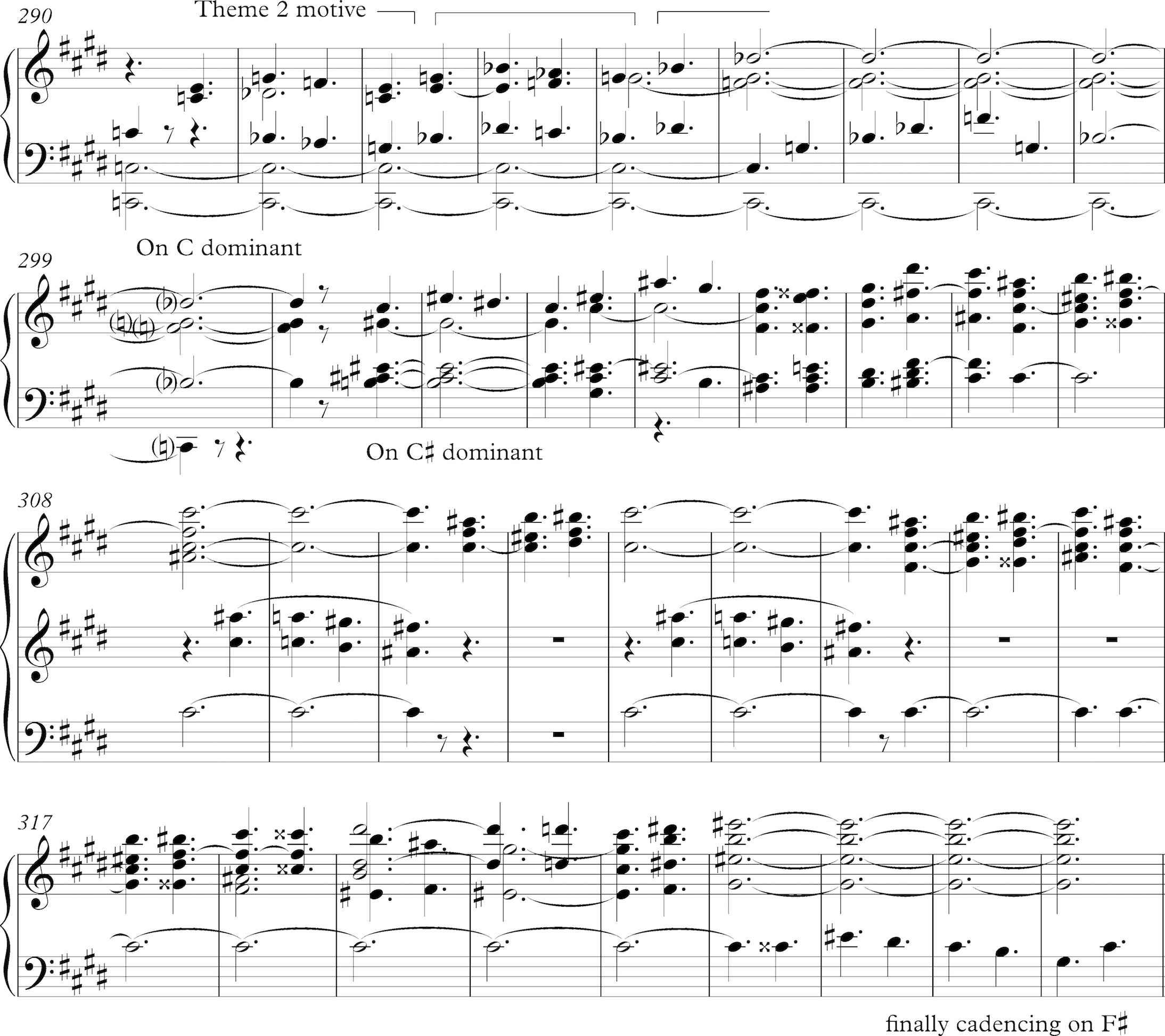
The coda to this little section is delightful: three times it starts from the fourths motive (adding the two half-steps C#-D and E#-F#, the symphony’s central motive) and then slides down in alternating major and diminished triads, an octave lower with each repetition.

The music takes up the closing theme motive again and modulates it from F# to B to E, and after a dominant preparation we’re in the recapitulation. (Keep in mind, the entire recapitulation and the bulk of the following coda are omitted from the Karl Krueger recording.)
In the recapitulation the first theme (mm. 378-393) is longer and modulates to B rather than C as in the exposition. Much transitional material is skipped (as in the first movement), and the anticipation of the second theme starts in B major/minor rather than F#. Oddly, the transition cadences at m. 422 in C major, and the second theme is heard in that key – including its digression into Db, parallel to the original second theme veering from G to Ab. The second theme is never heard in the tonic key of the movement, nor does any of the closing theme material appear in the recapitulation – curious departures from sonata conventions.
A presto section begins at m. 508, but one is tempted to say that the coda actually begins at m. 476, since Bristow introduces a new theme, though a brief and simple one, in the horns, with trumpet fanfare. As in the first movement, chromatically moving minor thirds lead to a dominant preparation, with much emphasis in the lower brass on the thematic dyads C-B and E-D#. The following presto is the whirlwind of celebratory triplets one would expect to close so long a symphony, but there are some surprises. At m. 528 the music edges up to Ab major for a bass melody whose rhythm (I’m thinking of the 16th-notes) seems to refer briefly to the close of the first movement, but which develops the closing theme.

At m. 548 this entire figure is reiterated in C major, and at m. 568 it seems to reappear in Db major, though that material is somewhat simpler. The orchestral bombast slips through diminished seventh chords back to E major at m. 580. The extended denouement alternates the tonic chord with the major and minor subdominants, and indeed – over a dramatic timpani roll, the minor subdominant is the last chord we hear before the concluding E. The ending is in E, but not unambiguously in E major.
I would advance this symphony as possibly the best American symphony written before Charles Ives’s First (though I don’t have Bristow’s Fifth for comparison). Bristow’s strength lies not in his thematic material, which is unexceptional, but in that he was a born sonata-allegro composer. He can expertly modulate within a theme, and even signal to the listener whether the modulation is only momentary or more structural. He can delay a definitive cadence with the best of Wagnerians. He doesn’t like so much to develop motives as to repeat themes and bend them, sometimes exquisitely, to different purposes each time. One of his quirks is that he repeats so much of his high-profile expositional material in the development section that (in the first and last movements) by the time the recap has passed one feels like one’s heard everything three times; this surely accounts for the temptation to cut his music.
Bristow’s symphonic ambitions are large. One might say that this mammoth first movement attempted a Mahlerian breadth with only a Beethovenian number of themes, so that much of its length is taken up by transitions and long, modulating chord progressions buoyed by repeated motives. He also had a Beethovenian sense that masses of orchestral tone can be so overwhelming that crescendos need to be built up slowly and decrescendos released just as slowly, so the music ebbs and swells with a leisureliness that might try the patience of listeners more inured to modern disruptions. Above all, it sounds like a piece written by someone who spent his life sitting in the orchestra and absorbing the sonorities and the style.
Hear George Frederick Bristow’s Symphony No. 4 in e minor, Op. 50, “Arcadian” below.
Read about George Frederick Bristow here.
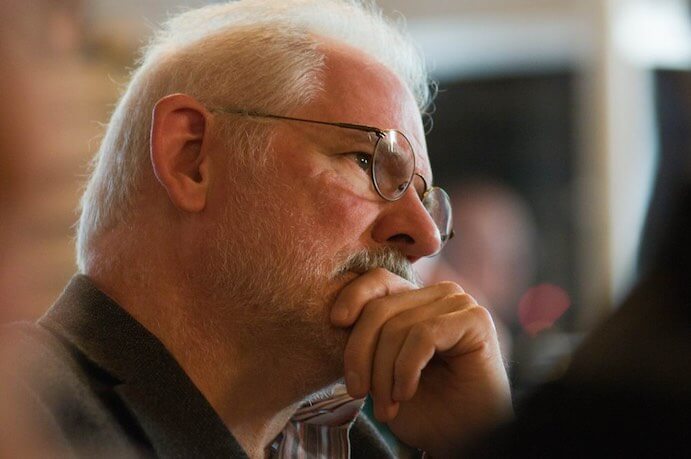 Kyle Gann (b. 1955 in Dallas, Texas) is a composer and was new-music critic for the Village Voice from 1986 to 2005. Since 1997 he has taught at Bard College. He is the author of seven books on American music, including books on Conlon Nancarrow, Robert Ashley, John Cage’s 4’33”, and Charles Ives’s Concord Sonata. He studied composition with Ben Johnston, Morton Feldman, and Peter Gena, and much of his music is microtonal. His major works include the piano concerto Sunken City, Transcendental Sonnets for chorus and orchestra, the microtonal music theater piece Custer and Sitting Bull and The Planets for mixed octet. Visit him at http://www.kylegann.com/.
Kyle Gann (b. 1955 in Dallas, Texas) is a composer and was new-music critic for the Village Voice from 1986 to 2005. Since 1997 he has taught at Bard College. He is the author of seven books on American music, including books on Conlon Nancarrow, Robert Ashley, John Cage’s 4’33”, and Charles Ives’s Concord Sonata. He studied composition with Ben Johnston, Morton Feldman, and Peter Gena, and much of his music is microtonal. His major works include the piano concerto Sunken City, Transcendental Sonnets for chorus and orchestra, the microtonal music theater piece Custer and Sitting Bull and The Planets for mixed octet. Visit him at http://www.kylegann.com/.Category Sight, Sound, Word | Tags:
Comments Off on George Frederick Bristow: Symphony No. 4 in e minor, Op. 50, “Arcadian” (1872) – Fourth movement: Allegro con spirito, “Arrival at the New Home, Rustic Festivities, and Dancing” – An Analysis by Kyle Gann
Sorry, comments are closed.

